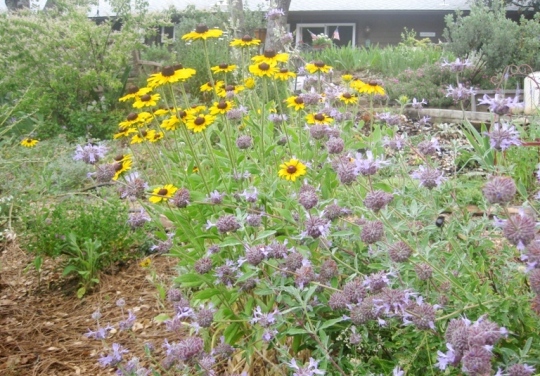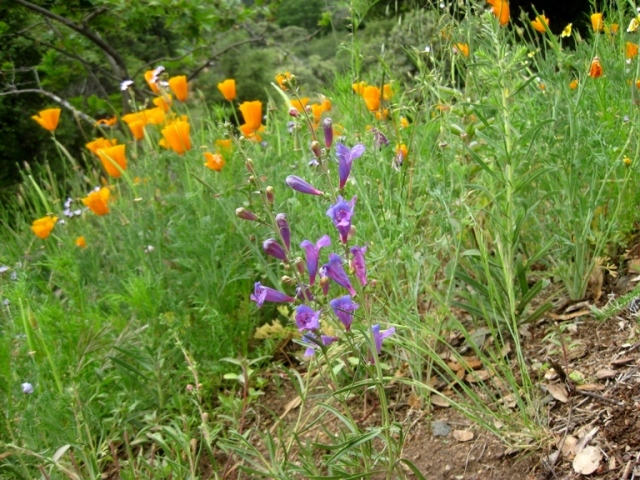Have you ever noticed a striking color combination when planting flowers together by chance? You suddenly see that the hot pink rockrose bloom looks stunning with lime and burgundy euphorbia. Or you see that an orange Monkey flower contrasts wonderfully with an iridescent lavender-blue Cleveland sage ‘Pozo’. I recently became aware of this particular combo and determined to plant an orangey yellow Monkey flower by every sage I had.
These unexpected pairs can also be planned. In the past, I’ve acted as a sort of ‘plant collector,’ planting one or two of things I impulsively see at nurseries. These get dotted around where ever I think best in the garden. At best it can look like a cottage garden, at worst, a real mess. Now, especially now working in a huge space, I want to purposefully plan to repeat the plant combinations I’ve seen to design a fabulously colorful look in your garden.
Color is not the only consideration in plant pairs. Greens with two different textures can also work well together. The front planting bed with a spiky Bird’s Nest Spruce looks fabulous with a fine textured, small leafed ground cover, Germander Teucrium, both in a similar color of deep green. Now I think broad leafed plants with grasses, big leaves with small and color wise, grey-green foliage with yellow or forest green. Since blooms only last through the spring and summer, these different greens and textures can carry the garden nicely through the ‘off’ season.

A natural combination, creamy white Bush Beardtongue, Keckiella breviflora, with lemon yellow Elegant Madia
I take my inspiration from plant pairs I’ve seen by chance in my own garden, in magazine pictures or in nature. Haven’t you noticed that many wildflowers occur naturally in opposite colors? Orange and blue, yellow and purple?
These are some pairs that I’d like to repeat around the garden, planning more swaths (a new favorite word when talking about the garden) of planned color and texture combinations. Take a look and see what you think, then I’d like to know what plant combos you’ve found, too.
Plant Combinations shown in this post:
- Lime green Marjoram with Spiky Bearded iris
- Chrome yellow coreopsis with glowing rose colored Jupiter’s beard
- Blue Cleveland sage with yellow-gold Black-eyed Susans
- True Blue flax, with purple Wallflower ‘Bowles Mauve’plus burgindy Red-Tipped Photinia
- Orange California poppy with soft Baby blue eyes
- Orange California poppy with Penstemon ‘Margarita BOP’
- Iridescent blue-purple Foothill penstemon with soft yellow Pretty Face, Triteleia ixioides
- Sulfur flower, Eriogonum umbellatum with Spirea japonica ‘Gold mound’
- Feathery White yarrow with clear blue Penstemon ‘Margarita BOP’
- Creamy white Bush Beardtongue, Keckiella breviflora, with lemon yellow Elegant Madia
- Euphorbia dulcis ‘Chameleon’ with Orchid Rockrose
- Euphorbia dulcis ‘Chameleon’ with Spanish lavender














5 comments